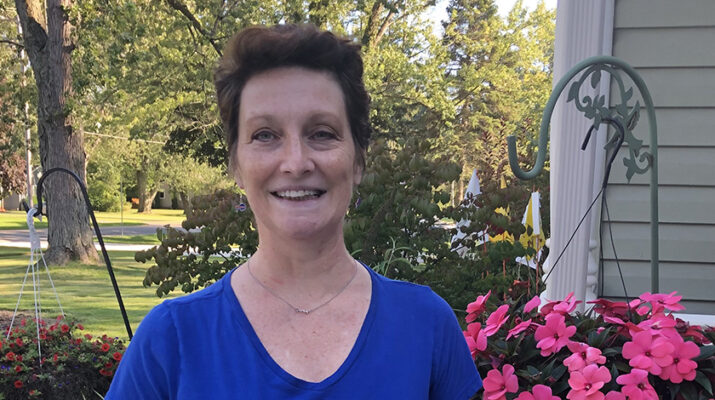Cathy Nichols of Amherst has been a big advocate for women to get screened for breast cancer
By Jane Schmitt
Cathy Nichols is an untiring advocate of mammography because she knows that the odds of surviving breast cancer greatly increase when the disease is diagnosed and treated in the beginning stages.
In fact, the American Cancer Society describes early detection as central to its goal “to ensure everyone has an opportunity to prevent, detect, treat and survive cancer.”
“I’ve always been a true believer that if you have something ailing you, get it checked out before it gets worse,” said Nichols, an Amherst woman whose own cancer journey began in mid-2021 when her annual screening revealed irregularities in her left breast.
Now done with treatment, she’s a champion for others who have heard those dreaded words from their doctor: “It’s cancer.”
“I hope people see me as an example. Catching the cancer early was the biggest thing,” Nichols said. “I still have my breasts. What if I had waited six months? Or a year? How bad would things have been then? Would cancer have taken my breast? Would it have been in my lymph system or somewhere else? We need to pay attention to our bodies.”
For her, annual mammograms started at age 21 after discovery of a fibroid tumor. Decades went by with no major issues until July 2021, when an ultrasound showed calcification in her breast and her doctor ordered a biopsy.
The diagnosis was ductal carcinoma in situ, or DCIS.
“I was shocked. There was a moment of ‘Are you kidding me?’ I would never have known because there were no physical signs, no symptoms. There was no lump that I felt,” said Nichols, 51. “Imaging caught it. Had they not caught it, what could have happened?”
Thus began a journey that so many others have gone on, with a referral to an oncologist followed by more tests, then surgeries and a treatment plan that included chemotherapy. Next was radiation therapy, which her doctor ordered five days a week for four weeks.
“Luckily, I didn’t have any nausea. I had an appetite, but everything tasted different because of the medications,” she said. “I hadn’t had a Big Mac in decades and one Saturday my husband took our son swimming and he called me on the way home to see if I needed anything. It was probably the first day of treatment and I said, ‘I need a Big Mac!’ So my loving husband got me one.”
Spreading the message
Nichols was determined to not let the cancer diagnosis affect her and her family more than was necessary.
“My mindset was, ‘I’m going to get through this.’ There are people who have gone through worse and had bigger surgeries and lived through it,” she said. “I wanted to keep my daily life as normal as possible.”
That wasn’t easy, however. And she had her share of low points.
“After my second surgery, I came home and sat on the couch and started to cry. My husband asked what was the matter and I said, ‘This just sucks.’ He said, ‘That’s OK, just let it out.’ Ten minutes later, I was good,” Nichols said. “I just needed that ‘woe is me’ moment.”
When the cancer treatments caused her hair to come out in clumps, her hairdresser shaved her head. Her husband, Joe, showed his support by shaving his head, too.
“He really stepped up. He wanted to do everything — the laundry, the meals. It was almost too much for me sometimes because I’m kind of a control freak,” Nichols said. “The days I was in bed, just exhausted and feeling lousy, he was fabulous — so doting. If I needed anything, he was always right there. But if I needed to be left alone, he left me alone.”
She turned to social media to post treatment updates and encourage others to pay attention to their health and wellness. Inspiring people to take action and get screened was a priority, fueled by her own experience and something special she had created at home.
“One thing that helped me through it was what I call my Inspiration Wall. So many people sent me cards, notes, little gifts and pick-me-ups. I took all of those and put them on a wall that we walk by multiple times a day,” she said.
Now she is firmly focused on the future, with a post-treatment regimen that includes six-month checks via mammograms and ultrasounds. And she continues to spread the message that early detection of cancer can save lives.
“After my first surgery, I went out for girls’ night with three friends. One was a cancer survivor. The other two were delayed on their mammograms. They made their appointments the next day,” she said.

